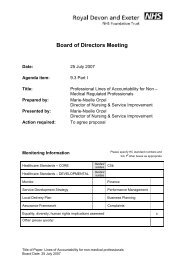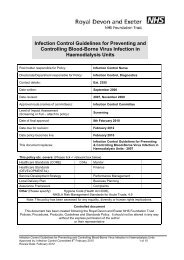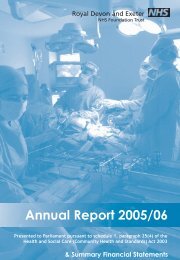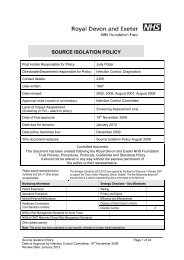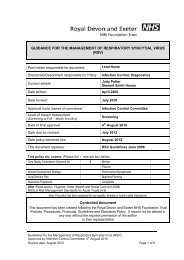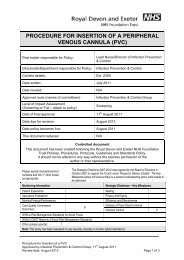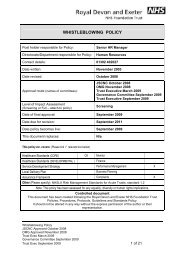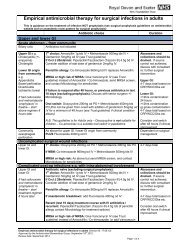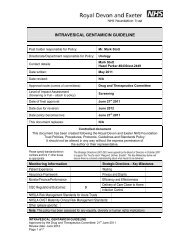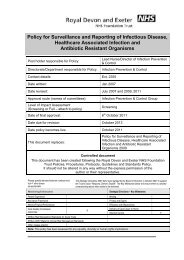Annual Report and Accounts 2012/13 - Royal Devon & Exeter Hospital
Annual Report and Accounts 2012/13 - Royal Devon & Exeter Hospital
Annual Report and Accounts 2012/13 - Royal Devon & Exeter Hospital
You also want an ePaper? Increase the reach of your titles
YUMPU automatically turns print PDFs into web optimized ePapers that Google loves.
26 2. Progress on our<br />
<strong>2012</strong>/<strong>13</strong> Priorities<br />
<strong>Royal</strong> <strong>Devon</strong> <strong>and</strong> <strong>Exeter</strong> NHS Foundation Trust<br />
Quality <strong>Report</strong> <strong>2012</strong>/<strong>13</strong><br />
CASE STUDY<br />
Pressure ulcers – zero tolerance<br />
approach to care-acquired skin damage<br />
Pressure ulcers are a type of injury that<br />
breaks down the skin <strong>and</strong> underlying<br />
tissue. They are caused when an area<br />
of skin is placed under pressure. They<br />
are also sometimes known as 'bed<br />
sores' or 'pressure sores'.<br />
Pressure ulcers can range in severity<br />
from patches of discoloured skin<br />
to open wounds that expose the<br />
underlying bone or muscle. The<br />
damage is usually caused by pressure,<br />
the weight of the body pressing down<br />
on the skin, <strong>and</strong> can occur when<br />
patients are moved incorrectly or<br />
nursed in chairs or on mattresses that<br />
are not suitable for their risk.<br />
The most common places for pressure<br />
sores are over bones that are close to<br />
the skin like the bottom, heel, elbow,<br />
ankle, shoulder, back <strong>and</strong> back of<br />
the ear. Patients are more at risk of<br />
developing a pressure ulcer if they:<br />
• Have difficulty moving <strong>and</strong> cannot<br />
change position<br />
• Cannot feel pain over part or all of<br />
their body<br />
• Are incontinent, are seriously ill, or<br />
have had surgery<br />
• Have a poor diet <strong>and</strong> don’t drink<br />
enough water<br />
• Are very young or very old<br />
• Have damaged their spinal cord<br />
<strong>and</strong> can neither move nor feel<br />
their bottom <strong>and</strong> legs<br />
• Are older people who are ill or<br />
have suffered an injury like a<br />
broken hip.<br />
* The red line in the graph indicates the Trust's target achievement for the year <strong>2012</strong>/<strong>13</strong>.<br />
Pressure ulcers cause patients<br />
long-term pain <strong>and</strong> distress <strong>and</strong> 95%<br />
of them are avoidable. As well as<br />
causing pain <strong>and</strong> discomfort, pressure<br />
ulcers also result in patients staying in<br />
hospital longer than planned.<br />
Avoiding pressure ulcers is a key<br />
indicator of the quality of nursing care.<br />
Tackling pressure ulcers<br />
Pressure ulcers are graded according to<br />
severity, with grade 1 being the least<br />
serious <strong>and</strong> signalling a precursor to<br />
pressure damage <strong>and</strong> grade 4 being<br />
the most severe. The Trust has had no<br />
grade 4 pressure ulcers in <strong>2012</strong>/<strong>13</strong>.<br />
The graph above shows the reduction<br />
in grade 2 <strong>and</strong> 3 pressure ulcers.<br />
If a patient comes into hospital with<br />
a pressure ulcer or develops damage<br />
whilst a patient, they will be seen<br />
by a Tissue Viability nurse who will<br />
undertake an assessment <strong>and</strong> ensure<br />
their care is the best we can deliver<br />
to resolve the pressure ulcer as soon<br />
as possible. This may involve specialist<br />
equipment, moving <strong>and</strong> h<strong>and</strong>ling,<br />
wound management, dietary input <strong>and</strong><br />
continence advice.



